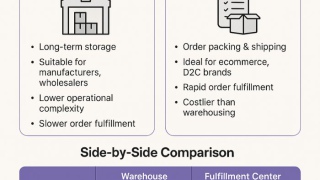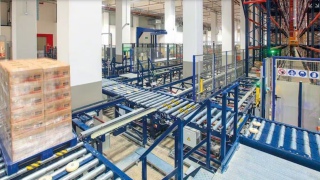Smart Warehousing: AI, Robotics, and WMS Trends Shaping Logistics in 2025
As we cross into 2025, the logistics industry is rapidly evolving with the rise of the smart warehouse — a tech-enabled approach transforming traditional storage into dynamic, data-driven ecosystems. With global supply chains under pressure to deliver faster, cheaper, and greener, smart warehouses are emerging as the cornerstone of modern logistics. Here’s how key technologies are leading the charge.

AI-Powered Optimization in Smart Warehousing
Artificial Intelligence (AI) has become the brain behind smart warehouse operations. From demand forecasting to inventory management, AI algorithms enable real-time decision-making. Predictive analytics optimize storage layouts, minimize downtime, and reduce human error. In 2025, AI is increasingly integrated into Warehouse Management Systems (WMS), making operations adaptive to shifting market demands.
Robotics Revolution in Modern Warehouses
Autonomous mobile robots (AMRs), robotic picking systems, and automated guided vehicles (AGVs) are now essential components of a smart warehouse. These robotics solutions handle repetitive tasks, increase throughput, and reduce injury risks. By collaborating with human workers, robots enhance productivity and create hybrid environments where efficiency and flexibility coexist.
IoT and WMS: Driving Connected Warehousing
The Internet of Things (IoT) connects every shelf, sensor, and forklift. In a smart warehouse, IoT devices monitor temperature, track assets, and alert managers to anomalies. RFID tags and GPS enable real-time visibility, improving accuracy across supply chain nodes. This connected ecosystem empowers WMS platforms to react faster and smarter.
Cloud-Based WMS and Edge Computing Synergy
Cloud solutions continue to dominate the smart warehouse landscape, offering scalability and remote access. In parallel, edge computing — processing data locally — supports real-time responses. Warehouses now deploy hybrid systems that reduce latency, boost reliability, and ensure uninterrupted performance even during network disruptions.
Machine Vision, Robotics, and AI for Quality Control
Advanced cameras paired with computer vision algorithms — a subset of AI — identify defects, verify shipments, and guide robotics systems. These solutions bring a new level of precision to packaging, labeling, and sorting tasks. In 2025, machine vision is not just improving quality — it’s driving accountability and compliance in smart warehouses.
Cybersecurity for AI-Driven Smart Warehouses
As digital tools proliferate, so do vulnerabilities. Smart warehouses rely on secure networks and encrypted communications to prevent cyber threats. Multifactor authentication, regular audits, and employee training are vital components of a robust cybersecurity strategy — especially when WMS and AI systems control core logistics.
Conclusion: Smart Warehousing as a Strategic Asset
Smart warehousing in 2025 is no longer a futuristic dream — it’s a competitive necessity. By embracing robotics, AI, and advanced WMS, logistics companies are unlocking new levels of efficiency, accuracy, and responsiveness. For businesses ready to adapt, the warehouse becomes more than a storage space; it’s a strategic asset driving growth and innovation.
_0x70_d59.png)



